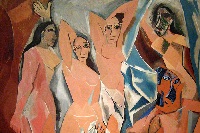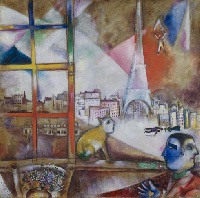This was a movement that looked at the subject in a new way and from different viewpoints by analyzing breaking it up into an abstracted form. Pablo Picasso and Georges Braque were two of the main leaders of this movement.
ARTISTS
EVENTS & EXHIBITIONS
Synthetic Cubism
1912-1914
Synthetic Cubism was a movement within the Cubist movement. It was sparked by Pablo Picasso's "Still Life With Chair Caning," and introduced collage to twentieth-century modernism. It made use of new materials, textures, and surfaces in two-dimensional art, and elevated collage to "high" art.
Other artists associated with this movement include Georges Braque and Juan Gris.
Salon des Indépendants of 1911
1911-1911
The first exhibition to show Cubist work, which was displayed in its own room, ‘Salle 41.’
Orphism
1912-1913
Orphism was an off-shoot of Cubism that combined abstraction with Fauve color. It was founded by Robert Delaunay and his wife Sonia, and was featured at the Salon des Indépendants in 1913. Although it was a style that only a few artists picked up for a short while, the Delaunays continued to implement it for the rest of their careers.
Paris' rue Lafitte
1901-1901
This was the first major exhibition of Pablo Picasso's. It was known as a prestigious gallery at the time. A total of 75 works were displayed of his in this gallery. His work consisted of paintings, drawing, and sculptures.
Vorticism
1914-1914
A short-lived offshoot of Cubism that was also influence by Futurism. It was named by Ezra Pound and founded by Wyndham Lewis. They held only one exhibition, and the group came to an end with the beginning of World War I.











